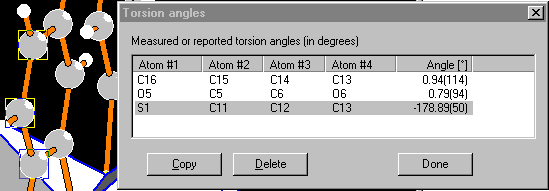|
Diamond can calculate distances between two atoms, angles between
three atoms, and torsion angles, each with standard uncertainties, presuming
that standard uncertainties have been defined for cell or atomic parameters.
Distances and angles can be calculated for selected atom types of the current
structure and within an arbitrary distance range, and listed in a special table
right beneath the structure picture (examples below, abbreviated; the lists
have been directly copied via clipboard from the Diamond data table)
|
Ti 1 F 8 1.732(4) 3x
F 1 2.026(5) 3x
Ti 2 F 10 1.720(6) 1x
F 6 1.745(4) 1x
F 1 1.895(4) 1x
F 5 1.914(5) 1x
F 3 1.947(4) 1x
F 2 2.037(5) 1x
Ti 3 F 7 1.708(4) 1x
F 9 1.732(4) 1x
F 4 1.874(5) 1x
F 2 1.891(4) 1x
F 3 1.995(5) 1x
< omitted for brevity >
F 1 Ti 2 1.895(4) Ti 1 2.026(5) 147.97(21)
F 2 Ti 3 1.891(5) Ti 2 2.037(5) 148.78(25)
F 3 Ti 2 1.947(4) Ti 3 1.995(5) 151.05(22)
F 4 Ti 3 1.874(5) Ti 4 2.058(5) 143.40(24)
F 5 Ti 2 1.914(5) Ti 3 2.002(5) 152.72(22)
|
|
Distances, angles, and torsion angles can be measured interactively in the
structure picture by clicking two, three, or four atoms, rsp., each. The results
may be added to the internal lists of distances or angles and appear as
geometric parameters in the data sheet and the CIF export as
"geom_dist_XXX" etc. - with standard uncertainties and symmetry
codes, of course.
|

|